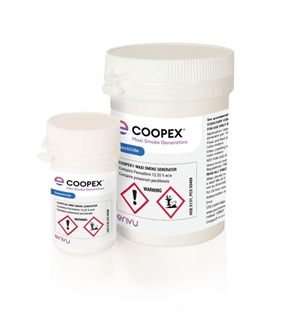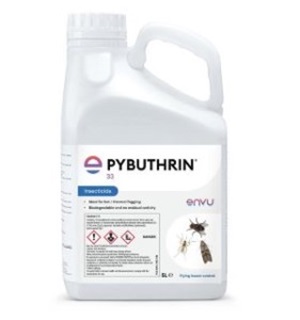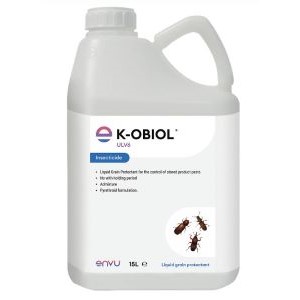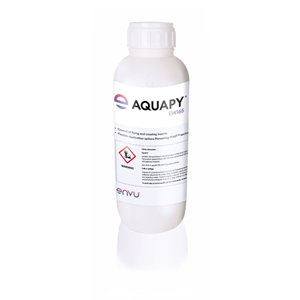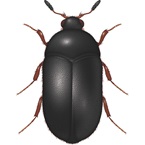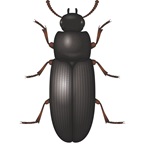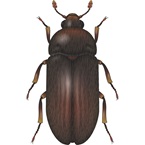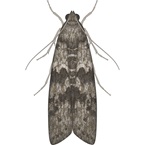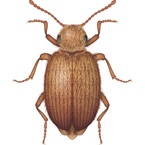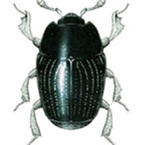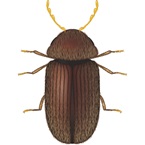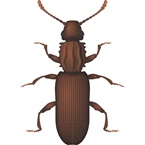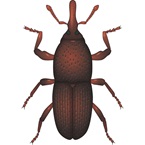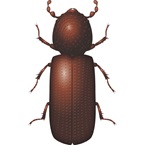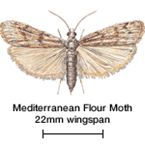Soft-bodied insects, rarely exceeding 6mm in length. Typical forms have two pairs of membranous wings, but there is an evolutionary tendency to loss of wings in many species. Antennae long and threadlike, with 12-50 segments; compound eyes, poorly developed; biting mouth parts; tarsi 2 or 3 segmented, each bearing two claws; incomplete metamorphosis with egg and nymphal stages.
Species characteristics:
Liposcelis bostrychophilus (bostrychophila)- Adults about 1mm long
- Colour, light brown
- Broad, flat hind femur
- No wing rudiments
- abdomen flattened
- Colour, yellowish brown, with conspicuous dark
- Reddish bands across abdomen
- Adults very active, about 1.5-2.0mm long
- Pale yellow or white in colour
- Well developed eyes
- Wing flaps present
- Rows of dark spots on front margins of some abdominal segments
- Adults about 2mm long
- Colour, dark brown or black
- Wing flaps present
Areas where found:
Most booklice species are found in natural habitats such as animal nests, tree trunk crevices, under bark (hence the alternative name of barklice) and on leaves. However, those species that have achieved pest status are widely distributed and often found in ware-houses, food manufacturing premises, granaries and museums
as well as domestic and retail premises. Here they will infest materials of plant and animal origin including stored food, plaster, leather, woodwork and even books.
Many species are cosmopolitan and their countries of origin are unknown. Different species exhibit different temperature requirements. Thus Lepinotus patruelis is frequently encountered in cool situations, e.g. warehouses, whilst Liposcelis bostrychophilus, which is thought to have originated from Africa, prefers warmer situations. In heated buildings continuously brooded species (e.g. Liposcelis spp.) will continue to breed throughout the year. Other species (e.g. Trogium spp.) produce only one generation per year and may overwinter as nymphs.
Psocids rarely cause damage directly by feeding and are virtually harmless in small numbers. Large infestations, however, may cause significant damage to delicate materials such as books and furs. Signs of spoilage of dried meat have included holes and tunnels in which the insects hide plus a covering of white powdery material
and salt crystals. The major problem posed by psocids is the nuisance which they cause. The insects will contaminate raw or processed foods. They may contribute to a gradual heating of grain stored in bulk with an eventual impairment of its properties and reduction in its value. Contaminated products must be identified and destroyed, which is timeconsuming and wasteful. Eggs may be downgraded because of spotting caused by the crushed bodies of dark booklice, e.g. Lepinotus
spp. Finished products may be infested in retail premises or in the home, with a consequent loss of goodwill. Pallets, dunnage and packaging may be infested and act as a source of infestation of stored products. Among the wide variety of commodities and materials which may be infested by psocids are the following: bagged nuts, bat guano, chocolate, fish meal, milk powder, museum specimens and books, oil seeds, processed cereals, pollen, salami, skin scales, springbok biltong, stored
cereal grains, sugar beet seeds, yeast and even damp plaster. Although harmless to man, booklice are often confused with true lice and therefore regarded with alarm. As well as infesting foodstuffs in the home they may be encountered swarming over furnishings and walls, including newly plastered surfaces which are still damp. Clearly, materials of both animal and vegetable origin may be attacked but the insects show an undeniable preference for micro-organisms, including bacteria, yeasts, moulds and algae, and populations will develop more successfully in damp conditions where these thrive. This close association with microorganisms results in these becoming entangled in their bodies and in this way the insects are instrumental in disseminating the organisms which cause spoilage.
Lifecycle:
(Based on that of Liposcelis bostrychophilus) The females of some species of booklouse may reproduce without fertilisation, the males being suppressed, dwarf or entirely lacking. During her life each female produces some 200 eggs. They are usually laid separately at a rate of 1-3 per day and, being sticky, become covered with framents of food or rubbish or adhere to the substrate. The eggs of some outdoor species are however laid in batches and covered with a silken web. The smooth, pearl-coloured eggs hatch in 1-2 weeks. The emerging nymph closely resembles the adult and will pass through 3-8 moults depending on species (four in the case of L. bostrychophilus) to reach maturity in about 15 days. With each successive moult the nymph becomes progressively more like the adult as eyes, antennae and wings (if present) begin to develop. Ambient conditions and the quality of the diet profoundly influence the speed of psocid development. The life-cycle is usually completed
in one month, the adults surviving for up to 6 months. The insects are only moderately well adapted to the environments they inhabit. Their small size and flattened bodies mean that they can readily hide in cracks and crevices. They do, however, possess a relatively thin cuticle which, coupled with a large surface/volume ratio, means that they are not well adapted to survive adverse conditions, and, in particular, low relative humidities.
Control:
a) Hygiene/management
Because of the opportunities for re-infestation, booklice are difficult to control with insecticides. The most effective method of control is to ensure that premises are thoroughly aired and dry, thereby deterring the development of moulds and denying the insects their food source. Commodities should be stacked neatly above the
floor level using pallets, away from walls and should not touch the ceiling. A gap between stacks will allow for ventilation, regular inspection, cleaning and, if necessary, treatment with insecticides (see recommended products). Badly infested commodities should be destroyed. Infested pallets can be identified by ‘knocking
out’, i.e. dropping a pallet held end on about 75mm (3”) above a sheet of white paper.
b) Insecticidal control
Booklice are susceptible to a wide variety of insecticides (see recommended products). The problem lies in ensuring contact between the pests and the toxicant in order to bring infestations under control.
___________________________________________________________________________________
Glossary of terms:
Tarsus (Tarsi): Apical section of leg (the foot).

